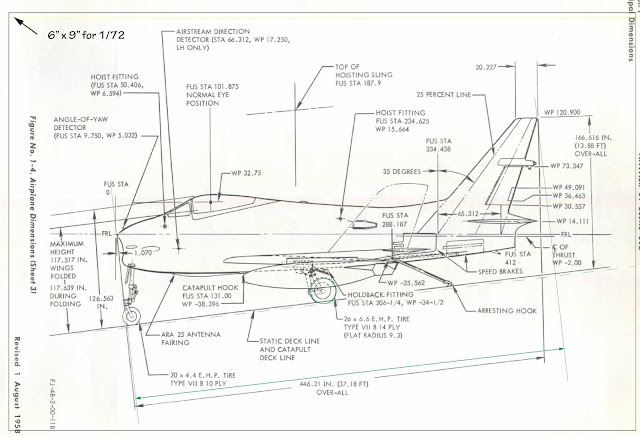The FJ-4 main landing gear was different from the FJ-2 and FJ-3's. It was a so-called trailing arm configuration, which separated the landing gear strut from the shock absorption function. My guess is that this was done in this instance to reduce the width of the landing gear when viewed from the front, because the FJ-4 wing was thinner to increase the airplane's critical Mach number (there are other benefits - see John Eaton's comment below).
This is the best picture I've found so far of the configuration:
Note that the piston of the shock strut extends above it and shock strut is attached to the one-piece trailing arm forward of the wheel's axle. Roughly speaking, a line drawn between the trailing arm pivot point (see below) and the wheel axle should be parallel to the ground.
Static-display FJ-4s may have the shock strut fully collapsed as in this picture:
Photo by Fotios Rouch
What's worse, the display FJ-4B might not have the correct wheel hub:
Bill Spidle Photos
The actual main landing gear hub/wheel appears to be identical to the F4D's:
https://tailspintopics.blogspot.com/2015/07/its-not-that-easy-to-avoid-error.html
The main landing gear is angled aft, probably because of the desired location for the mounting structure in the wing versus the required location of the wheel relative to the airplane cg. The trailing arm is not accurately depicted - it actually has a kink in it between the gear strut and the wheel as shown above.
The kink in the trailing arm is required to allow full extension of the shock absorber.
The main landing gear wheel doesn't appear to have changed during its service life, always being the "forged" configuration. The nose landing gear wheel does seem to be different in some instances.
Note that the "link" extending aft of the shock strut is attached to the swiveling section of the nose landing gear and "rides" a ramp in the wheel well to mechanically rotate the wheel so it lies flat in the wheel well.
Proper "sit" is important to a model's appearance on its landing gear. Note however, that it will vary with the weight of the airplane (with and without full fuel and external stores). If the airplane's brakes are applied while it is being towed or pushed back, the nose gear strut may also compress or extend slightly, changing the true static sit.
Note that I've corrected the original drawing for height vs width using the water lines versus fuselage stations and also sloppy drafting. The dashed line is the location of the ground with respect to the overall heights given above the canopy and the vertical fin. (For 1/48, the box is 9" x 13.5")










Tommy, the trailing beam gear allows a lot more travel and a softer reaction than a normal oleo struts integral with the gear. I have flown both versions of the Cessna 414 which had both type gear and the landing shock is far less with the trailing beam gear.
ReplyDelete